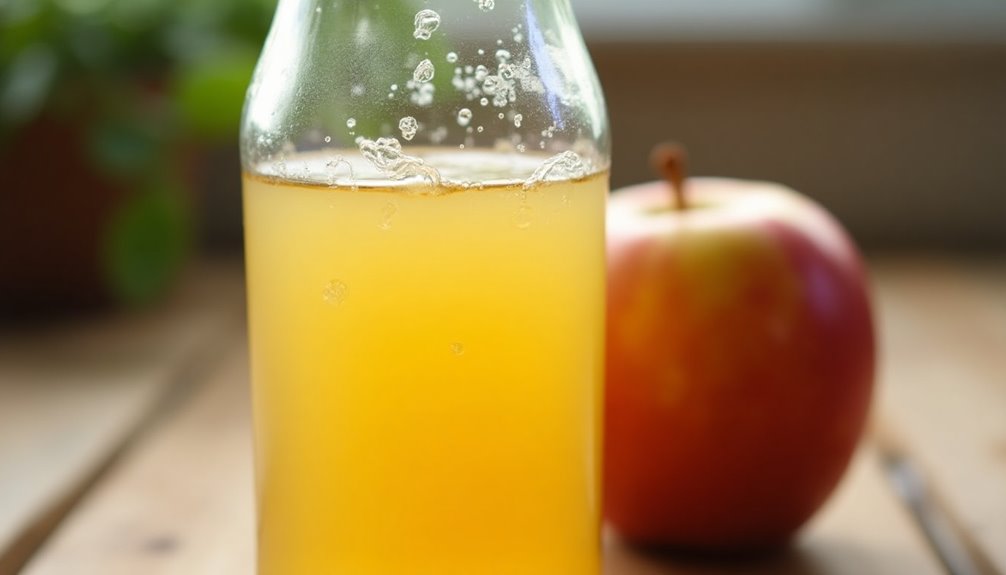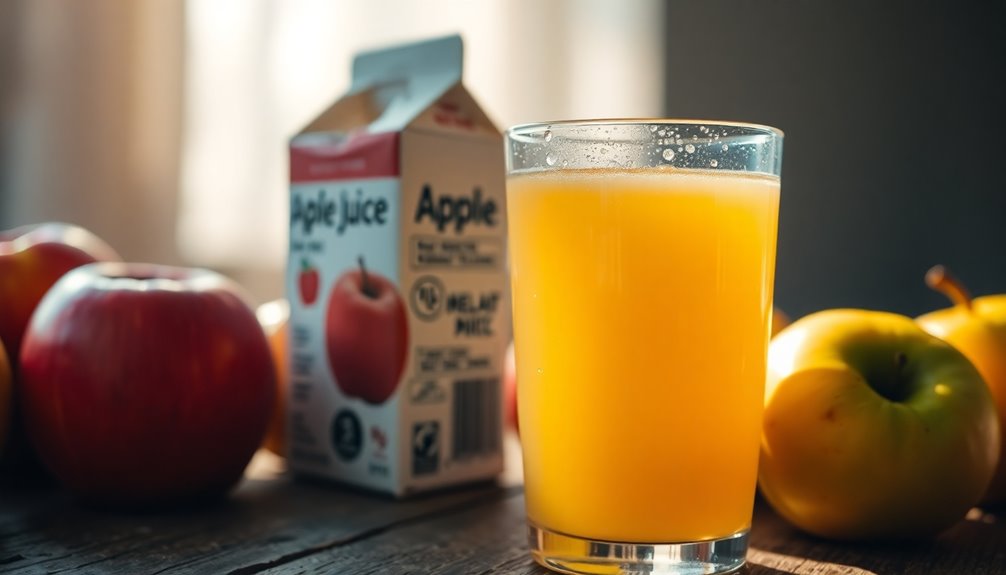Once you open apple juice, it's good for about 7 to 10 days in the refrigerator. If you're drinking cold-pressed apple juice, you'll want to finish it within 2 to 3 days for optimal taste and safety. Always store it tightly sealed and keep an eye out for any signs of spoilage, like mold or off-odors. Keeping track of when you opened it can help, and there's more important storage info to consider.
Key Takeaways
- Opened apple juice lasts about 7 to 10 days when stored in the refrigerator.
- Cold-pressed apple juice should be consumed within 2 to 3 days after opening.
- Always refrigerate apple juice immediately after opening to slow spoilage.
- Signs of spoilage include mold, off-odors, and discoloration; discard if noticed.
- Keep containers tightly sealed and label with opening date for better tracking.

When you crack open a bottle or can of apple juice, it’s essential to know how long it stays fresh to avoid any health risks. Opened apple juice typically lasts about 7 to 10 days when properly stored in the refrigerator. This timeframe helps ensure you enjoy the juice at its best quality while also safeguarding your health. If you’ve opened a carton of store-bought apple juice, make it a point to consume it within that week to ten-day window. Additionally, it’s crucial to check for any signs of spoilage, such as an off smell or unusual discoloration, before consuming. Keeping the juice tightly sealed can help maintain its freshness for as long as possible. Therefore, understanding how long apple juice lasts after opening allows you to enjoy its delicious flavor without compromising your health.
If you're drinking canned apple juice, remember that it should also be consumed within 10 days to maintain its safety and freshness. Unlike bottles, cans can sometimes have a slightly different shelf life due to the packaging. Always keep them in the refrigerator after opening; this helps slow down spoilage and keeps the juice tasting good.
For cold-pressed apple juice, the situation is a bit different. Once opened, you should aim to consume it within 2 to 3 days for optimal quality. Cold-pressed juice is less processed, which means it lacks some of the preservatives that extend the life of other types of apple juice. Thus, it's even more crucial to pay attention to how long it's been in your refrigerator after opening.
Another critical factor to consider is temperature. If you leave opened apple juice out at room temperature for over 2 hours, it becomes unsafe to consume. The risk of spoilage increases significantly, and harmful bacteria can develop. So, if you've had a glass and you're thinking about saving the rest for later, make sure to get it back in the refrigerator quickly.
Be vigilant for signs of spoilage. Mold, off-odors, or discoloration are all telltale indicators that your apple juice has gone bad. If you spot any of these signs, it's best to discard the juice, regardless of how long it's been since you opened it. Freshness matters, and you don't want to compromise your health over a few sips of juice.
Frequently Asked Questions
How Long Is Apple Juice Good for After Opening?
When you open a bottle or carton of apple juice, you've got a limited time to enjoy it.
Store-bought apple juice typically stays fresh in your fridge for about 7 to 10 days. If it's canned, aim to finish it within a week.
Cold-pressed juice is best consumed within 2 to 3 days, while homemade juice usually lasts just 48 hours.
Always check for spoilage signs before taking a sip!
How Long Does Opened Juice Last in the Fridge?
Imagine you've just opened a refreshing bottle of orange juice for breakfast. You wonder how long it'll stay fresh in the fridge.
Generally, opened juice lasts about 7-10 days, depending on the type. Freshly squeezed juice should be consumed within 2-3 days for optimal taste, while store-bought varieties can last longer.
Always check for spoilage signs, like off odors or changes in color, before taking a sip to ensure quality.
How Long Is Martinelli's Apple Juice Good for Once Opened?
Once you open Martinelli's apple juice, it's best to drink it within 7 to 10 days if you store it in the refrigerator.
Make sure to seal it tightly after each pour to keep it fresh.
If the juice sits out for more than 2 hours, toss it to avoid safety risks.
Always check for any sour smells, cloudiness, or mold before drinking, especially as it nears that 10-day mark.
Is It Okay to Drink Old Apple Juice?
Drinking old apple juice might feel like a daring adventure, but it's a risk you shouldn't take!
If the juice smells sour, appears cloudy, or has strange floaties, it's definitely time to toss it.
Even if it looks fine, if it's been sitting out for more than two hours, you're playing
Conclusion
Once you've opened that bottle of apple juice, it's best to enjoy it within 7 to 10 days for peak freshness. Just think about it: who wants to sip on stale juice when you could be savoring its crisp, sweet flavor? By storing it in the fridge and keeping the lid tightly sealed, you can maximize its shelf life. So, next time you crack open a bottle, remember to drink up before it loses its deliciousness!
Cindy thoroughly researches juicing trends, techniques, and recipes to provide readers with practical advice and inspiration. Her writing style is accessible, engaging, and designed to make complex concepts easy to understand. Cindy’s dedication to promoting the advantages of juicing shines through her work, empowering readers to make positive changes in their lives through the simple act of juicing.











